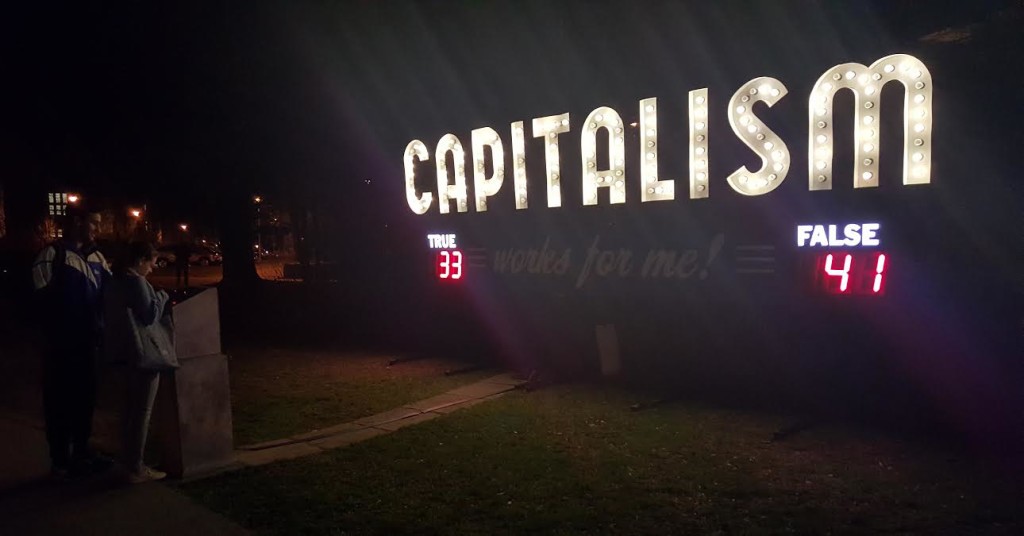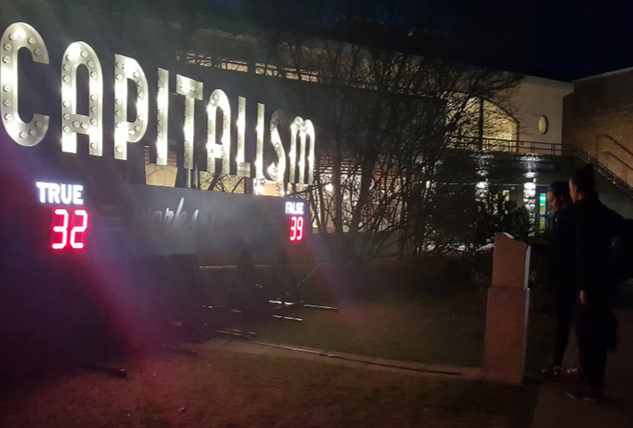With its gaudy twinkling letters and blaring red scoreboard, the Capitalism Works For Me! public art piece currently positioned out- side of Cro is tough to miss–but perhaps that’s the point. Designed by artist Steve Lambert to spark- conversation about our economic system, the piece has served as a rarity in promoting these frequently silenced conversations around the country. “I realized there wasn’t really a space for people to talk about capitalism and how to make it better,” Lambert explained, while displaying the piece in Times Square.
The art piece was originally brought to campus to commemorate the 10th anniversary of the Center for the Comparative Study of Race and Ethnicity (CCSRE) and to represent the culmination of the Center’s year long study on capital. Center Director and Education Department Chair Professor Sandy Grande describes that students spent the past year examining the intersections of race, capital and capitalism.
The Center had always wanted to incorporate a public art piece into their studies, but Grande worried that after discovering Lambert’s work, the possibility of bringing it to campus would be slim. However, after contacting the artist and the current holder of the art piece, The Station Museum in Houston, Texas, possibility quickly shifted to reality. With the support of the Art Department and CCSRE student members, arrangements were made for the political piece to be brought across the country for viewing and conversation at Conn.
At the Station Museum, Capitalism Works for Me! was featured as part of an exhibit titled “Corpocracy.” As detailed by the modern art museum’s website, “Corpocracy is defined as the absurd reality of our society in which corporations and their interests are allowed to have dominance over the economic and political systems. Through the subversive imagination, the artist works toward a transformation of social consciousness.”
A prominent political artist and founder of The Center for Artistic Activism, Lambert frequently explores and challenges the use of advertising and public space with his art. He is the creator of “ad-art,” a Firefox add-on that replaces advertising with art and The New York Times Special Edition, a parody of the newspaper which advocated for an end to the Iraq War.
When discussing Capitalism Works For Me! within our own community, many individuals discussed the multiple interpretations of the piece. When voting, individuals are presented with the statement, “In my life this statement is…” and must then select true or false. While some students interpreted the statement “Capitalism Works For Me!” as approving or disapproving of capitalism, others viewed it as posing whether or not an individual benefits from capitalism as an economic system.
Grande describes that she believes the artist intended for this dual meaning to create a rich and challenging conversation. Similar to Lambert, she hopes that these interpretations will spark a broader community dialogue on capitalism, one which rarely occurs outside of academic classrooms.
Art Professor Chris Barnard further described that while some students may have an initial gut reaction after seeing the statement, “Capitalism Works For Me!” the process of voting may promote deeper thinking. He expressed that it’s important to see capitalism as a two-way street and question not just, “How am I navigating through capitalism?” but also, “How is capitalism working on me?”
Barnard also expressed the importance of recognizing the manual labor required to create, transport and continuously reconstruct the art piece. “I hope people credit all of those involved on the project, the people who unloaded crates, those who put it all together and the individuals who brought it up from Houston and interacted with curators.”
While the art piece serves as a source of critical discussion about capitalism, it is equally important to take note of the system of capitalism that went behind creating the art and making its show- casing at Connecticut College possible. Unsurprisingly, reactions to the art piece have been mixed. While some students voted “yes” and were quick to state their support for our current capitalist system, many others challenged the economic system and who benefits from it.
“I voted no because although capitalism works for me, it doesn’t work for everyone and only a few can benefit. It doesn’t serve the collective community and my life is very intertwined with people in my community,” described Emma Horst-Martz ’18. For those interested in continuing the conversation, staff, faculty, students and community members are welcome to attend a faculty debate on inequality, racism and capitalism on April 26 in Ernst Common Room from 4:30-7p.m. Sponsored by the CCSRE, the debate will feature three faculty who represent three distinctly different perspectives on capitalism: Court- ney Baker of the English Department, Ed McKenna from the Department of Economics and Edward Stringham, Davis Professor of Economic Organizations and Innovation at Trinity College.
The event will include discussion of the public art piece and the intersection of race, capital and capitalism. Community members are also invited to continue voting on whether capitalism works for them on the following dates:
Every Wednesday 11:50-1:00pm and 5:30-7pm
(April 6th, 13th, 20th & 27th) Monday, April 11th 11:00-1:00pm Monday, April 18th 11:00-1:00pm Friday, April 22nd 10:00-12:00pm Tuesday, April 26th 1:00-4:00pm •









